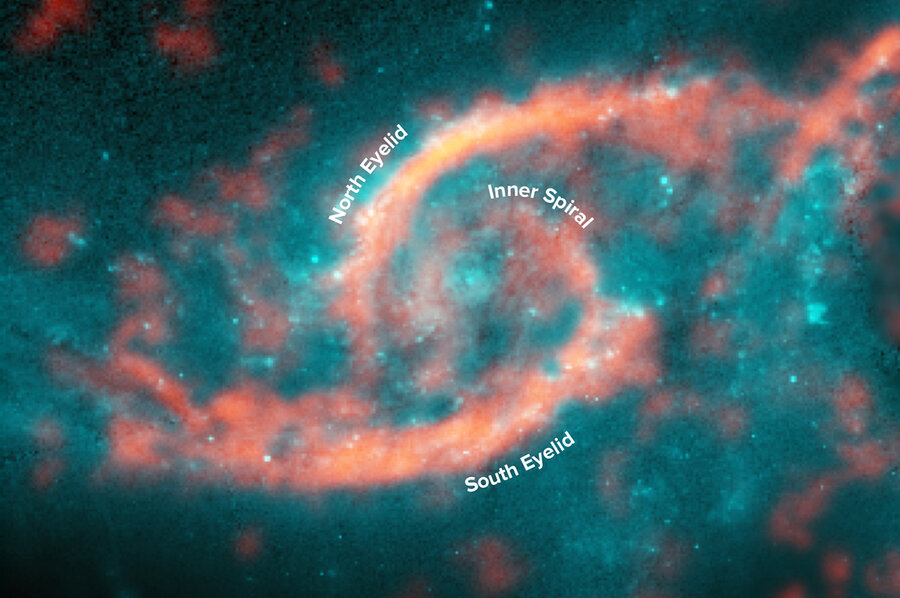Cosmic fender-bender: Colliding galaxies create rare eye-shaped formation
Loading...
Far beyond our galaxy, a swirling stellar tsunami has created a pair of watchful cosmic eyes.
Using the Atacama Large Millimeter/submillimeter Array (ALMA), a high-resolution telescope in the Chilean Andes, astronomers have discovered a rare star formation. The structure, which looks remarkably like two eyelids, was produced by the grazing collision of two spiral galaxies. Researchers described the formation in the Astrophysical Journal on Friday.
“Although galaxy collisions of this type are not uncommon, only a few galaxies with eye-like, or ocular, structures are known to exist,” lead author Michele Kaufman, an astronomer formerly with The Ohio State University in Columbus, said in a statement. “Finding one in such a newly formed state gives us an exceptional opportunity to study what happens when one galaxy grazes another.”
Galactic eyelid formations only last “a few tens of millions of years,” Dr. Kaufman says – an extremely short life on the cosmic scale. That may explain why so few have ever been recorded.
When IC 2163’s outer arm clipped NGC 2207’s spinning disk, the collision produced brilliant formations of stars, dust, and gas. Kaufman and colleagues spotted the two spiral galaxies some 114 million light-years from Earth, utilizing ALMA’s high sensitivity and resolution to track the movement of carbon monoxide gas at the intersection of the two.
New research suggests that gas from IC 2163’s outer “eyelid” is spiraling inward at over 100 kilometers per second. But the gas slows down as it approaches the center, and begins to follow the normal rotation of the galaxy.
“What we observe in this galaxy is very much like a massive ocean wave barreling toward shore until it interacts with the shallows, causing it to lose momentum and dump all of its water and sand on the beach,” co-author Bruce Elmegreen, a scientist with IBM’s T.J. Watson Research Center, said in a statement.
Researchers also found that the molecular gas became denser as it decelerated. That compression caused the formation of new star clusters and characteristic eyelid features, Kaufman said.
“This evidence for a strong shock in the eyelids is terrific,” co-author Curtis Struck, an astrophysicist at Iowa State University, said in a statement. “It's all very well to have a theory and simulations suggesting it should be true, but real observational evidence is great.”
ALMA, which was designed to detect early galaxies and star-formation ingredients, began operation in 2009. Its radio dishes collectively form an interferometer, which combines signals from multiple antennas to produce more detailed data.
The Christian Science Monitor’s Pete Spotts reported:
Where a single antenna might see something that looks like a relatively broad blur, an interferometer can look at the same object and see one large, and other smaller objects that are actually there. The bigger the virtual antenna, the more closely spaced distant objects can be and still be detected as individual objects. The array also will be vastly more sensitive to very faint radiation coming from large, blob-like molecular clouds -- so-called extended sources for millimeter and submillimeter radiation.
Earlier this month, researchers at the ALMA observatory imaged Elias 2-27, a distant young star with spiral arms. The star’s gaseous disk could provide new clues about the mechanics of planetary formation. In July, it became the first telescope array to capture so-called “stellar snow.”








